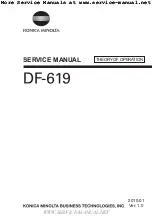
ORNAMENT
•
8
USER MANUAL
on the contrary it will almost always be silent. Experiment with the duration of the cells, as
well as the mode of their operation, to find interesting tones at the moments when two or
more LYRA voices sound connected in the FM synthesis mode.
Рiс. 3
This principle of creating durations is more like how we create music when we simply play a
musical instrument. We think in lengths of sounds and pauses between them. Later, in order
to effectively interact with other musicians, we are forced to put music on a grid, relative
to which everyone else will be guided.
Pass the trigger by connecting
TRIG
5
(put this cell in positive mode) to
TRIG
1
to
complicate the patch a bit more (connection
TRIG
4
—
TRIG
1
remains). Now the first
cell is activated not only when the fourth cell “releases” LYRA, but also when the fifth cell
also “releases” LYRA. You can set the length of the fifth cell so that all the cells will almost
constantly “hold” LYRA. To avoid this, you can put them all in negative mode. The pattern
in the end turned out to be very complicated, but if you change the duration of the first
and fifth cells, the behavior will instantly change. Therefore, ORNAMENT•8 is a synthesizer
of behavior, which only in some special cases can be called a sequencer in the usual sense.
Connecting each of the remaining inputs and outputs increases the functionality and com‑
plexity of the behavior of the ORNAMENT many times, if not exponentially.
Put all used cells in positive mode. Remove the connections
TRIG
5
—
TRIG
1
,
TRIG
3
—
TRIG
5
so that only
LOOP
remains. Set the
TIME
durations of all cells so that they
are about the same. Start
LOOP
with one of the
SET
buttons. Then activate another
cell from
LOOP
so that two cells are active in the loop at each moment. If the
TIME
parameters are equal for all four cells, then three cells, or even all four, can be active in the
loop. But such states will not be stable and soon enough the number of active cells in this
loop will decrease to two.
In a sense, this is the natural mechanism of the ORNAMENT, which does not allow too many
cells in the loop (and therefore too many LYRA voices) to be active at the same time. As
long as the cell is active (and “holds” LYRA), its input
TRIG
is not susceptible to new trig‑
ger pulses. And if almost all cells are active in the loop, the “eating” or absorption of new
incoming pulses by already active cells is inevitable. The reasons for this lie in the unequal
time of the activity of the cells.
Since the ORNAMENT has a completely analog circuit, the cell durations can be approximately
equal, but they will never be exactly equal. One of the cells will inevitably work longer than
the others by a small margin, and sooner or later it is bound to “eat” an additional pulse
circulating in the system, thereby removing it.
Let’s call such moments "collisions", when our system, as a result of extraordinary events,
by itself radically changes its state.
Linear sequencers avoid collisions, they are simply not possible. There is a main Master Clock
that dictates to everyone when to “go,” and when to “stand.” In the ORNAMENT, each
part is equal. All involved cells participate in the formation of all states at all inputs and
outputs, while living their individual lives, so to speak, in their own independent rhythm. If
you remove or rebuild one of the links, the result will immediately change. Collisions are the
essence of ORNAMENT, which makes it the first sequencer of its kind.
Hold
RESET
on any of the
LOOP
cells to clear the loop by causing all pulses to be
“eaten”. At the moment the
RESET
button is pressed, the active cell instantly turns off
(stops “holding” LYRA), and a trigger is generated at the
TRIG
output. If after pressing it,
you continue to hold
RESET
, then the input
TRIG
of this cell will be blocked and will not
Summary of Contents for ORNAMENT-8
Page 1: ...USER MANUAL ...
Page 13: ...ORNAMENT 8 USER MANUAL Рiс 1 ...
Page 17: ...ORNAMENT 8 USER MANUAL Рiс 3 ...
Page 19: ...ORNAMENT 8 USER MANUAL Рiс 4 ...
Page 21: ...ORNAMENT 8 USER MANUAL Рiс 5 ...
Page 23: ...ORNAMENT 8 USER MANUAL Рiс 6 ...
Page 25: ...ORNAMENT 8 USER MANUAL Рiс 7 ...
Page 26: ...ORNAMENT 8 USER MANUAL Рiс 8 ...













































